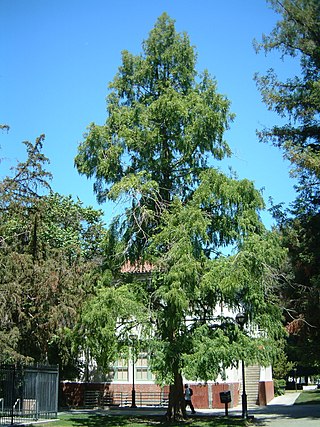
Metasequoia glyptostroboides, the dawn redwood, is a fast-growing, endangered deciduous conifer. It is the sole living species of the genus Metasequoia, one of three genera in the subfamily Sequoioideae of the family Cupressaceae. It now survives in the wild only in wet lower slopes and montane river and stream valleys in the border region of Hubei and Hunan provinces and Chongqing municipality in south-central China, notably in Lichuan county in Hubei. Although the shortest of the redwoods, it can grow to 167 ft (51 m) in height.

Wellington Botanic Gardenki Paekākā is a botanical garden close to central Wellington in New Zealand. It covers 25 ha of land in a valley between Thorndon and Kelburn, with Glenmore Street as a boundary along the valley floor. One of the access points is from the top of the Wellington Cable Car. The garden is managed by Wellington City Council, and features protected native forest, conifers, plant collections and seasonal displays and an extensive rose garden. It is classified as a Garden of National Significance by the New Zealand Gardens Trust. In 2004 it was listed as a historic area by Heritage New Zealand. Large sculptures and carvings are located throughout the garden.
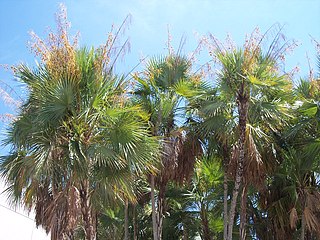
Acoelorraphe is a genus of palms with a single species Acoelorraphe wrightii, known as the Paurotis palm, Everglades palm or Madeira palm in English and cubas, tique, and papta in Spanish. The genus name is sometimes spelt as Acoelorrhaphe or Acoelorhaphe, which are treated by orthographical variants by the International Plant Names Index.

Viola sororia, known commonly as the common blue violet, is a short-stemmed herbaceous perennial plant native to eastern North America. It is known by a number of common names, including common meadow violet, purple violet, woolly blue violet, hooded violet, and wood violet.

Chionanthus ramiflorus, commonly known in Australia as northern olive or native olive, is a species of plants in the olive family Oleaceae. It is native to India, Nepal, northeastern Australia (Queensland), New Guinea, the Philippines, southern China and Taiwan.

Arisaema candidissimum is a species of flowering plant in the arum family (Araceae), originating in western China. Various English names have been given to the species, including Chinese cobra lily and Chinese jack-in-the-pulpit. The Chinese name is 白苞南星.

Magnolia 'Elizabeth' is a hybrid Magnolia that is the offspring of a cross between Magnolia acuminata (cucumbertree) and Magnolia denudata. It is the result of a breeding program to create yellow-flowered varieties conducted at the Brooklyn Botanic Garden beginning in 1953, and was named for Elizabeth Van Brunt, who donated funds to the Brooklyn Botanic Garden.

Begonia rex, the king begonia, is a species of flowering plant in the family Begoniaceae. It is found from Arunachal Pradesh to southeast China, and has been introduced to Bangladesh, Cuba, and Hispaniola. It is a parent to over 500 cultivars in the Begonia Rex Cultorum Group of houseplants. Other parents in the multitude of crosses made during the creation of the Group include Begonia annulata, B. cathayana, B. decora, B. diadema, B. dregei, B. grandis, B. hatacoa, B. palmata, and B. xanthina.
Begonia echinosepala is a species of flowering plant in the family Begoniaceae, native to southeastern Brazil. A bush reaching 6 ft (180 cm), it is infrequently offered in the nursery trade.
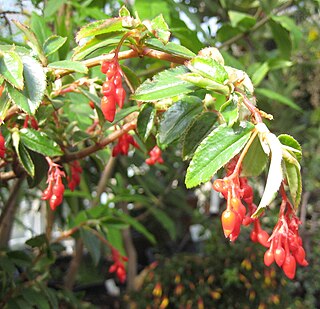
Begonia fuchsioides, the fuchsia begonia, is a species of flowering plant in the family Begoniaceae. It is native to Ecuador, Colombia, and western Venezuela, and has been introduced to Hawaii and Réunion. A small bush reaching 2 ft (60 cm), it is hardy to USDA zone 10a.
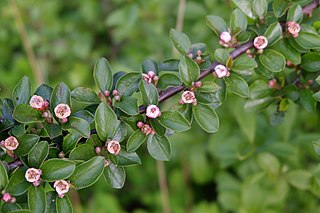
Cotoneaster divaricatus, the spreading cotoneaster, is a species of flowering plant in the family Rosaceae. It is native to China, and has been introduced to Ontario in Canada, the Midwest United States, northern and central Europe, Kenya, and the South Island of New Zealand. A shrub reaching 1.8 m (6 ft) tall but spreading to 2.4 m (8 ft), and hardy in USDA zones 4 through 7, it is considered a valuable landscaping plant by the Missouri Botanical Garden. The Centre for Agriculture and Bioscience International lists it in its Invasive Species Compendium.

Indigofera amblyantha, the Chinese indigo or pink-flowered indigo, is a species of flowering plant in the family Fabaceae, native to central and southern China. A non‑climbing shrub reaching 6 ft (2 m), it blooms from May to September, and is recommended for hedges, borders, massing, and containers.
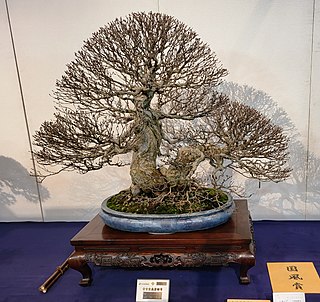
Carpinus turczaninovii, the Turczaninow hornbeam or Korean hornbeam, is a species of flowering plant in the family Betulaceae, native to central China, the Korean Peninsula, and central and southern Japan. It is a large shrub or small tree typically 15 to 20 ft tall and about 75% as wide, and is hardy to USDA zone 5b. It is available from commercial suppliers, and can handle very hard pruning.
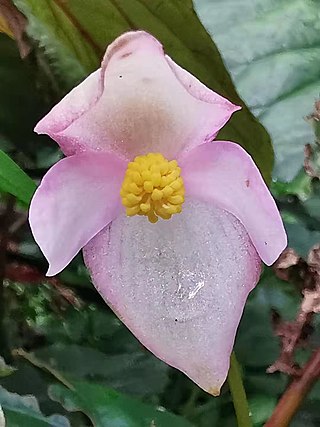
Begonia chitoensis, the hardy Taiwan begonia, is a species of flowering plant in the family Begoniaceae, native to central and northern Taiwan. It is found growing in forests at elevations from 400 to 2,200 m. As its common name suggests, it is hardy to USDA zone 7b.
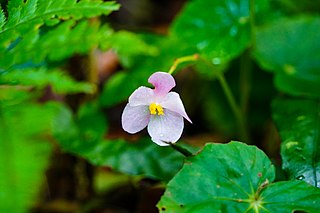
Begonia formosana is a species of flowering plant in the family Begoniaceae, native to Taiwan and the Ryukyu Islands. It is found growing in forests in shady, moist situations at elevations from 700 to 900 m.
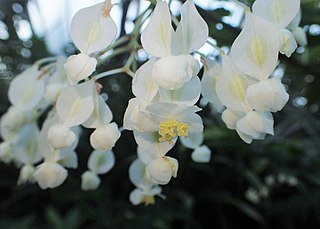
Begonia undulata, the wave leaved begonia, is a species of flowering plant in the family Begoniaceae, native to Rio de Janeiro state of Brazil. One of the more widely cultivated cane begonias, it is typically 1.8 m (6 ft) tall, but can reach 5.5 m (18 ft) if left to its own devices.
Begonia longifolia is a species of flowering plant in the family Begoniaceae. It is native to the eastern Himalayas, southern China, Hainan, Taiwan, mainland Southeast Asia, and some of the islands of Indonesia. An erect perennial herb reaching 1.5 m (5 ft), it is typically found in shady, moist forests at elevations from 200 to 2,200 m. It is the most widespread species of Begonia in Asia, and probably in the world.
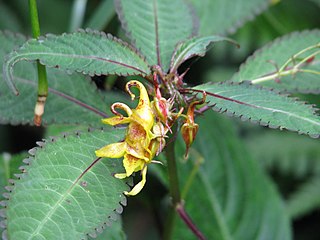
Impatiens stenantha, the narrow-flowered balsam, is a species of flowering plant in the family Balsaminaceae. It is native to Tibet, northwestern Yunnan, Nepal, the eastern Himalayas, Assam, and northern Myanmar. An annual or perennial typically reaching 40 cm (16 in), it is found in the understory of mixed forests and thickets at elevations from 2,400 to 3,000 m above sea level. It may be conspecific with Impatiens angustiflora, which is found only in Meghalaya and was also described by Hooker in 1875. It is available from garden suppliers.
Begonia taliensis is a species of flowering plant in the family Begoniaceae. It is found from Arunachal Pradesh in India, to Sichuan and Yunnan in China. A deciduous tuberous geophyte reaching 0.5 m (20 in), it is typically found in scrublands and forests at elevations from 1,300 to 2,400 m. Its leaves can be up to 25 cm (10 in) long, with a mix of purplish, green, and silvery green blotches. The flowers are small and pink. It is available from commercial suppliers as a houseplant.

Begonia emeiensis, the Mount Emei begonia, is a species of flowering plant in the family Begoniaceae. It is native to Sichuan, apparently only to the slopes of Mount Emei, one of the Four Sacred Buddhist Mountains of China. A rhizomatous perennial that resembles Begonia dielsiana, it is usually 0.5 m (20 in) tall, and is typically found growing amongst other scrubby vegetation alongside streams at elevations from 900 to 1,000 m. The flowers are 4 cm (1.6 in) wide, and pale pink. Hardy to −10 °C, it is available from commercial suppliers.
















